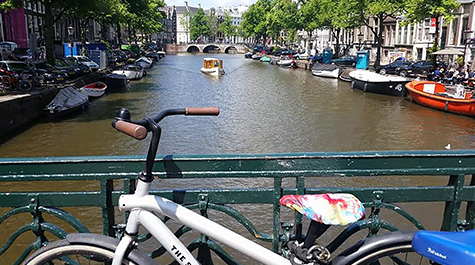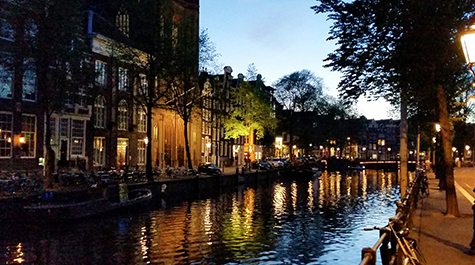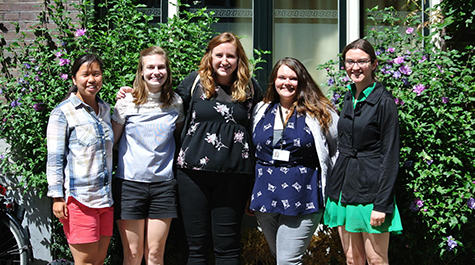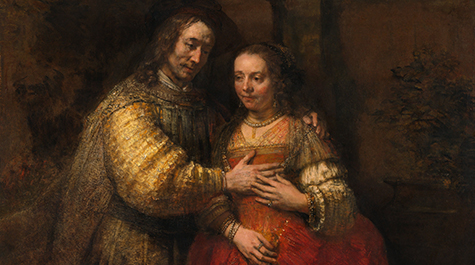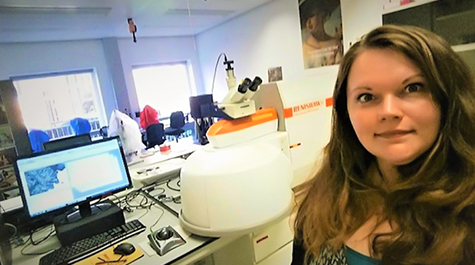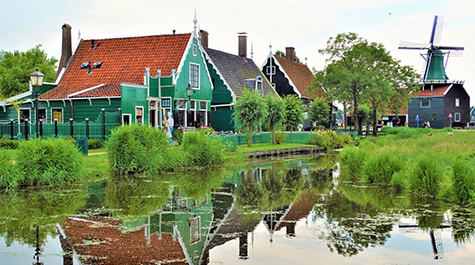At the Crossroads of Art and Science
by Anne Grasselli
Imagine being awarded the opportunity to live and work in one of Europe’s most treasured destinations for the summer, a city with more bicycle traffic than pedestrians or cars, with winding canals and tall, narrow buildings and streetlights that illuminate the rhythmic, quiet rippling of the water at dusk. Imagine, for a moment, that one of the world’s most renowned art museums housing some of our history’s most valuable and cherished art works opened its doors to you and invited you to work in its conservation lab. Imagine being Shelle Butler, a second-year master’s student in the William & Mary Department of Chemistry and the recipient of one of the National Science Foundation’s coveted grants, part of its International Research Experience for U.S. Students (IRES) program. She was awarded a spot through a specific program called the Cultural Heritage Research in the Netherlands, which is administered through Northwestern University.
Butler, together with only one other recipient, had the unique opportunity this past summer to work in Amsterdam’s Rijksmuseum in the Ateliergebouw, the building that houses the museum’s art conservation laboratories. More specifically, she worked with extraordinary and highly acclaimed paintings by the most famous of all Dutch masters, Rembrandt van Rijn (1606-1669). Butler was tasked with the important mission of working toward a conservation plan for these precious paintings, with the goal of preserving them for long-term enjoyment and study. Because of her coursework and hands-on experiences here at William & Mary, in addition to her passion for both forensic science and art, she could not have been a more natural fit for this weighty responsibility.
Butler’s original plan had been to become a forensic scientist, but she fell into the art world through her experiences with the Colonial Williamsburg Foundation (CWF) and her work with her two mentors, Shelley Svoboda, the Senior Art Conservator at CWF, and Kristin Wustholz, Associate Professor of Chemistry at W&M. Butler discovered that her work with art conservation was in fact similar to forensic science, noting that both fields require extensive investigation and the use of very specific scientific techniques. “Before joining the Wustholz lab, I wasn’t fully aware of such a captivating intersection between both of my passions: art and science.” According to her, conservation is actually the “fusion of passions,” further pointing out about her unique experience in Amsterdam, “When do you get to sit at the crossroads of art and science?”
From Svoboda and Wustholz, Butler learned a new technique for analyzing and identifying the make-up of pigments in historical works of art, focusing on period colors (i.e. carmine and madder red). The so-called Svoboda-Wustholz Technique begins with the collection of minute paint samples, which are then treated with silver nanoparticles. The samples are then subjected to a laser beam, which creates an interaction between the paint sample and the silver nanoparticles in a process called surface-enhanced Raman spectroscopy (SERS). The SERS process creates a “vibrational fingerprint” from the organic pigment, thus allowing for the color’s chemical make-up to be identified. The W&M lab where Svoboda and Wustholz developed their technique has a homemade set up that includes an entire floating laser table, which is more accurate and complex than the commercial Raman microscope being used at the Ateliergebouw.
Butler was responsible for sharing this technique with the Ateliergebouw in order to enhance and bring up-to-date the pigment analysis processes that were already in use in the conservation lab there. She did, however, have to pass a test before beginning her work in order to ensure that she could be trusted with the materials. The test entailed identifying a pigment from one of Rembrandt’s most compelling paintings, The Jewish Bride, which happens to be Butler’s all-time favorite painting by the artist, adding a level of intimidation to the process. The sample had been collected from what is called an “area of loss” along the edges of the painting, which is traditionally hidden by the frame, and had been previously analyzed using another pigment identification method. Butler had to use SERS to prove that her method could pick up the organic compounds that the normal Raman microscope was not equipped to do. Not only did she pass the test, but she spent the following eight weeks writing a “how-to” manual for conservators, other fellows, and scientists at the Ateliergebouw laying out the procedures for analyzing paint samples using SERS. The manual not only includes how to test the paint samples, but also how to remove the silver particles from the sample and restore the artwork.
Wustholz, who was able to visit Butler while abroad, commented, “The Ateliergebouw was a beautiful, inspiring space filled with state-of-the-art instrumentation. Shelle was surrounded by light, color and art – a perfect place to be inspired to do great science.” Butler was also captivated by the beauty and special character of the city itself, including its open, public spaces and the houseboats lining the canals. She enjoyed music at the famed concert house, the Concertgebouw, and admired the resourceful nature of the Dutch, in general. She had the opportunity to tour the conservation labs at the Van Gogh Museum, noting that seeing unframed paintings by Van Gogh and Gauguin was equally as breathtaking and overwhelming as her initial sight of the Rembrandts at the Ateliergebouw. At the Rijksmuseum, she was able to tour all the conservation labs, including those used for textiles and metals, which she also found to be thoroughly fascinating. She pointed out with a certain amount of humor that walking through an art museum with other conservators could be something of a nightmare, for they know which works have been vandalized and which ones need more restoration, things that common museumgoers thankfully would not be able to spot.
As Butler has exemplified in her own studies, the relationship between art and science is a fascinating interplay between aesthetic ingenuity and scientific knowledge, such as the study of mathematics, optics, and perception. Chemistry, especially, has played a critical role in the evolution of organic (and non-organic) pigments through the years. Being able to study the original pigments and paintings with the staff of the Ateliergebouw was an extraordinary opportunity for Butler, who also noted that she was even able to visit De Kat windmill, where traditional recipes and methods are still used to grind pigments and create paints. A painter herself, Butler prefers working with acrylics, which are much less labor-intensive to produce.
After she completes a busy and productive second year in her master’s program, which will include additional research, compiling data, experimenting with new applications with SERS, and writing her thesis, Butler hopes to return to the Ateliergebouw for a longer stay. She felt that she had found her footing—and cycling—among the Dutch in Amsterdam and would welcome the chance to work again with the international staff and the masterworks in the collection at the Rijksmuseum. In her words, “Conducting research at the Rijksmuseum was definitely an experience of a lifetime, which has filled my sails to take me forward on my next journey after graduation from William & Mary.”
 Skip to main content
Skip to main content

